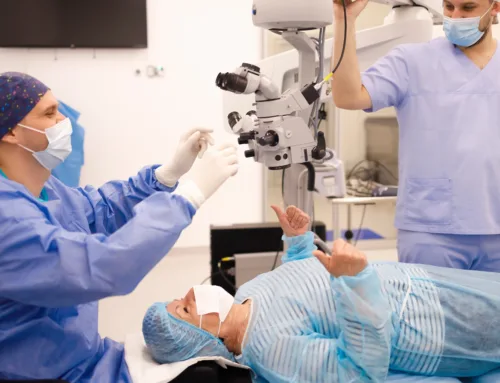If you’re over 55 and due to book in for cataract surgery, getting familiar with intraocular lens implant pros and cons is a critical step, since the IOL is a central component of the surgery. An intraocular lens implant is a clear, artificial lens that’s inserted into your eye during cataract surgery or refractive lens exchange, which allows you to regain clear vision.
What Are The Pros and Cons of Intraocular Lens Implants?
Pros of Intraocular Lens Implants
- Improved Vision Quality: Most patients experience significant improvement post-surgery, often achieving 20/20 vision or better.
- Reduced Dependence on Glasses: Many individuals find they can eliminate their need for glasses or contact lenses entirely.
- Quick Recovery: The procedure is generally quick; most patients return to normal activities within days with minimal discomfort.
- Long-lasting Results: IOLs are designed to last for decades, providing you with a durable solution for vision correction.
Cons of Intraocular Lens Implants
- Surgical Risks: As with any surgical procedure, there are risks involved, including infection, inflammation, and bleeding. In rare cases, the IOL may become dislocated or damaged.
- Adjustment Period: Some patients may experience visual disturbances such as glare or halos around lights, particularly at night. These issues may require additional treatment or adaptation time.
- Cost Considerations: While standard monofocal lenses are often covered by insurance, premium IOLs may not be fully covered and could incur out-of-pocket expenses.
- Limited Visual Range with Standard Lenses: Monofocal lenses typically correct vision at only one distance (either near or far), meaning you might still need glasses for certain tasks.
Detailed Comparison of IOL Types
It’s always a good idea to keep the IOL lens type you’d prefer in mind, as this allows you to cross reference a specific IOL’s characteristics and performance with the general pros and cons of intraocular lens implants.
| Type of IOL | Advantages | Disadvantages |
|---|---|---|
|
Monofocal Lenses Clear vision at a single distance; typically set for distance vision. |
Excellent for one focal distance (either near or far) | Requires glasses for other distances |
| Generally covered by insurance | May not provide optimal vision in low-light conditions | |
| Quick recovery | ||
|
Multifocal Lenses Multiple focal points for near, intermediate, and far distances. |
Provides clear vision at multiple distances | May cause glare or halos around lights |
| Reduces dependence on glasses | Not suitable for all patients (e.g., those with certain eye conditions) | |
|
Toric Lenses Designed to correct astigmatism, by compensating for the irregular shape of the cornea. |
Corrects astigmatism | May be more expensive than standard lenses |
| Can be combined with monofocal or multifocal options | ||
|
Accommodative Lenses Adjusts position within the eye to provide a range of clear vision. |
Mimics natural focusing ability | Not suitable for patients with previous eye trauma |
| Can help reduce dependency on glasses | ||
|
Extended Depth of Focus (EDOF) Enhances focus across distances while reducing visual disturbances. |
Provides a continuous range of vision | May not correct presbyopia as effectively as multifocal lenses |
| Reduces visual disturbances like halos | ||
| Light Adjustable Lenses (LAL)
Can be fine-tuned after surgery using light treatment to optimize vision. |
Allows for post-operative adjustments in lens power | Requires additional visits for adjustments |
For more information on which lens may be right for you, read our “Best Lens Implant For Cataract Surgery,” guide or discuss intraocular lens implant pros and cons with a cataract surgeon by using our directory to find one today.
What’s The Candidate Selection Criteria?
Not everyone is a suitable candidate for intraocular lens implantation. Ideal candidates typically include individuals over 50 years old who have cataracts or other conditions affecting their natural lens. Good overall health is also necessary since anesthesia is involved in the procedure.
Post-Surgery Care and Expectations
After receiving an IOL implant, it’s important to follow your surgeon’s post-operative care instructions closely to ensure optimal recovery. Most patients can expect their vision to stabilize within a few weeks but should attend follow-up appointments to monitor progress.
Find The Best Surgeon Near You Today & Get A Deep Understanding of IOL Pros and Cons
With IOL selection being a central decision with cataract surgery, it’s important to thoroughly evaluate the intraocular lens implant pros and cons before making your choice. If you’re ready to take the next step towards clearer vision, find the best surgeon near you today who specializes in cataract surgery and intraocular lens implants – your journey to better eyesight begins with an informed choice and expert care.










